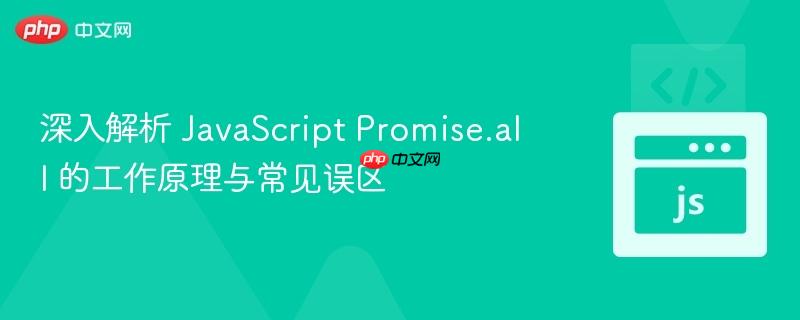
在现代 javascript 异步编程中,promise 及其相关静态方法扮演着至关重要的角色。其中,promise.all 是处理多个并发异步操作并等待它们全部完成的常用工具。然而,开发者在使用 promise.all 时,有时会对其输出行为产生困惑。本文将通过一个具体的例子,详细解释 promise.all 的工作机制,澄清常见的误解。
根据 MDN 文档,Promise.all() 静态方法接收一个 Promise 可迭代对象(例如数组)作为输入,并返回一个单一的 Promise。当输入的所有 Promise 都成功(或输入为空)时,这个返回的 Promise 才会成功,其成功值是一个包含所有输入 Promise 成功值的数组,顺序与输入 Promise 的顺序一致。如果输入的任何一个 Promise 失败,Promise.all 返回的 Promise 将立即失败,并返回第一个失败 Promise 的原因。
简而言之,Promise.all 的核心作用是:
让我们通过以下代码来理解 Promise.all 的行为:
// 一个在给定时间后解决的简单 Promise
const timeOut = (t) => {
return new Promise((resolve, reject) => {
setTimeout(() => {
resolve(`Completed in ${t}`);
}, t);
});
};
// 1. 单独解析一个 Promise
timeOut(1000)
.then(result => console.log(result)); // 输出: Completed in 1000 (约1秒后)
// 2. 使用 Promise.all 处理多个 Promise
Promise.all([timeOut(1000), timeOut(2000), timeOut(2000)])
.then(result => console.log(result)); // 输出: ['Completed in 1000', 'Completed in 2000', 'Completed in 2000'] (约2秒后)观察到的输出:
立即学习“Java免费学习笔记(深入)”;
Completed in 1000 ['Completed in 1000', 'Completed in 2000', 'Completed in 2000']
为什么会这样?
很多开发者可能会预期 Promise.all 的 .then() 回调之前,会先打印出 Completed in 1000、Completed in 2000 等单独的完成消息。然而,实际输出却并非如此。这主要是因为对 .then() 方法的理解和其作用范围的混淆。
timeOut(1000).then(result => console.log(result)) 这一行代码创建了一个独立的 Promise,并立即为其附加了一个 .then() 回调。当这个 timeOut(1000) Promise 在 1000 毫秒后解决时,它的 .then() 回调会被触发,并打印出 Completed in 1000。这个操作与 Promise.all 是完全独立的,它自己的 console.log 语句会在它自己的 Promise 解决时执行。
Promise.all([timeOut(1000), timeOut(2000), timeOut(2000)]).then(result => console.log(result)) 这里是关键。我们向 Promise.all 传入了一个包含三个 Promise 的数组。Promise.all 会等待这三个 Promise 全部解决。
Promise.all 返回的 Promise 会在所有内部 Promise 都解决后(即最慢的 Promise 解决后,这里是 2000 毫秒)才解决。当它解决时,它的 .then() 回调才会被触发。这个回调接收的 result 参数是一个数组,包含了三个内部 Promise 的解决值,即 ['Completed in 1000', 'Completed in 2000', 'Completed in 2000']。
重要的一点是: Promise.all 内部的 timeOut(2000) 等 Promise 并没有单独附加 console.log 语句。它们只是解决了,并将它们的解决值传递给了 Promise.all。因此,你不会看到 Completed in 2000 这样的独立输出,除非你显式地为这些 Promise 也添加了 .then() 回调。
Promise.all 的 .then() 回调只会在它所代表的聚合 Promise 成功时执行一次,其参数是所有子 Promise 结果的数组。如果你希望在每个子 Promise 完成时都进行一些操作(例如打印消息),你需要在将它们传递给 Promise.all 之前就为它们附加 .then() 回调,或者在 Promise.all 解决后,遍历其结果数组并进行处理。
例如,如果你想看到每个 Promise 的独立完成消息,可以这样修改:
const timeOut = (t) => {
return new Promise((resolve, reject) => {
setTimeout(() => {
console.log(`Individual Promise: Completed in ${t}`); // 在 Promise 内部打印
resolve(`Completed in ${t}`);
}, t);
});
};
// 1. 单独解析一个 Promise
timeOut(1000)
.then(result => console.log(`Separate .then(): ${result}`));
// 2. 使用 Promise.all 处理多个 Promise
// 注意:这里 timeOut 函数内部已经有 console.log
Promise.all([timeOut(1000), timeOut(2000), timeOut(2000)])
.then(result => console.log(`Promise.all result: ${result}`));修改后的输出示例:
Individual Promise: Completed in 1000 Separate .then(): Completed in 1000 Individual Promise: Completed in 1000 Individual Promise: Completed in 2000 Individual Promise: Completed in 2000 Promise.all result: Completed in 1000,Completed in 2000,Completed in 2000
(输出顺序可能因异步执行而略有不同,但关键点在于 Individual Promise 消息的出现。)
在这个修改后的例子中,timeOut 函数内部的 console.log 会在每个 Promise 解决时触发,而 Promise.all 的 .then() 则会在所有 Promise 都解决后,打印聚合结果。
Promise.all 是一个强大的工具,用于并发执行多个异步操作并收集它们的结果。理解其核心在于,它返回的是一个单一的聚合 Promise,其 .then() 回调只会在所有子 Promise 都成功后执行一次,并提供一个包含所有子 Promise 解决值的数组。避免将对单个 Promise 的 .then() 回调行为与 Promise.all 聚合 Promise 的 .then() 回调行为混淆,是正确使用 Promise.all 的关键。
以上就是深入解析 JavaScript Promise.all 的工作原理与常见误区的详细内容,更多请关注php中文网其它相关文章!

每个人都需要一台速度更快、更稳定的 PC。随着时间的推移,垃圾文件、旧注册表数据和不必要的后台进程会占用资源并降低性能。幸运的是,许多工具可以让 Windows 保持平稳运行。

Copyright 2014-2025 https://www.php.cn/ All Rights Reserved | php.cn | 湘ICP备2023035733号